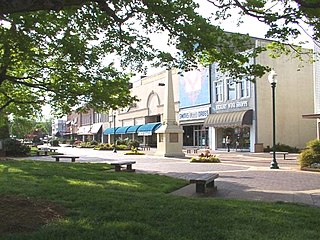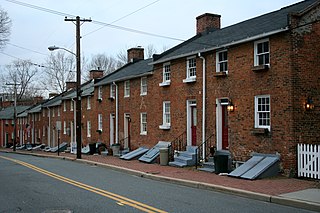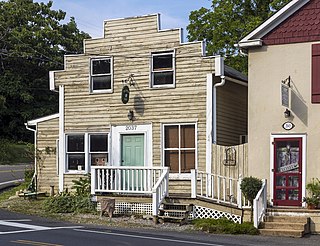
Catawba County is a county in the U.S. state of North Carolina. As of the 2020 census, the population was 160,610. Its county seat is Newton, and its largest community is Hickory.

Belmont is a small suburban city in Gaston County, North Carolina, United States, located about 9 miles (14 km) east of Gastonia. The population was 10,076 at the 2010 census. Once known as Garibaldi Station, it was named for the New York banker August Belmont. Belmont is home to Belmont Abbey College.

Hickory is a city in western North Carolina primarily located in Catawba County. The 25th most populous city in the state, it is located approximately 60 miles (97 km) northwest of Charlotte.

Oella is a mill town on the Patapsco River in western Baltimore County, Maryland, United States, located between Catonsville and Ellicott City. It is a 19th-century village of millworkers' homes.

Mountain Island is an unincorporated community in eastern Gaston County, North Carolina, United States. Not to be confused with the Charlotte neighborhood of the same name in Mecklenburg County. It is approximately 3 miles (4.8 km) north of Mount Holly.

Oakwood Historic District is a national historic district located at Hickory, Catawba County, North Carolina. It includes work designed by architects Wheeler & Stearn. It encompasses 50 contributing buildings, 1 contributing site, and 1 contributing structure in an upscale residential section of Hickory. It includes notable examples of Colonial Revival, Bungalow / American Craftsman, and Queen Anne style architecture dating from the 1880s to 1930s. Notable buildings include the Robert E. Simpson House (1922), Walker Lyerly House (1913), Cline-Wilfong House (1912), Abel A. Shuford, II House, Paul A. Setzer House (1927), John H. P. Cilley House (1912), (first) Charles H. Geitner House (1900), Benjamin F. Seagle House, David L. Russell House, Robert W. Stevenson House, Jones W. Shuford House (1907), Dr. Robert T. Hambrick House (1928), Alfred P. Whitener House, and J. Summie Propst House (1881-1883).

Millwood Commercial Historic District is a national historic district located at Millwood, Clarke County, Virginia.

The Merrimack Mill Village Historic District is a historic district in Huntsville, Alabama. The cotton mill was built in 1900 by the Merrimack Manufacturing Company, reaching a peak of 1,600 employees by 1955. The mill was sold in 1946, and became known as the Huntsville Manufacturing Company. It operated until 1989 and was torn down in 1992. Houses in the adjoining mill village were built between 1900 and 1937, and encompass many mill house styles not commonly seen outside New England. The district was listed on the National Register of Historic Places in 2010.

Glencoe Mill Village Historic District is a national historic district located at Glencoe, Alamance County, North Carolina. It encompasses 48 contributing buildings and 6 contributing structures built between 1880 and 1882 in Glencoe.
George Huffman Farm, also known as the Huffman-Herman Farm and Huffman-Punch-Herman Farm, is a historic farm and national historic district located near Conover, Catawba County, North Carolina. The district encompasses 2 contributing buildings and 1 contributing site. The main house was built about 1810, and is a two-story, single pile, frame, vernacular Federal style farmhouse. Also on the property are the contributing storage shed and Huffman Family Cemetery. Established by prosperous farmer, wagon-maker and cooper George Huffman, and farmed by his son-in-law William Punch later in the nineteenth century, the farm now lies fallow with most of the acreage wooded and heavily overgrown, yet the acreage continues to provide an appropriate setting for the built resources.

Catawba Historic District is a national historic district located at Catawba, Catawba County, North Carolina. The district encompasses 48 contributing buildings and 1 contributing structure in the rural village of Catawba. It contains 19th century farmhouses and tracts of farmland with scattered outbuildings as well as village residences and a small commercial district. The district includes notable examples of Gothic Revival, Victorian, and Bungalow / American Craftsman architecture. Notable buildings include the Bagby-Danner Farmhouse, Jacob D. Little House, Town Hall, Dr, Fred Y. Long Farm, Catawba ·Baptist Church, (former) Catawba High School (1921), Quintus M. Little House, Trollinger-Sherrill House, Brawley-Lowrance House, Pitts-Little House (1924), Manson L. Wilkinson· House, Sherrill Tobacco Company Building, Catawba Drug Company, Pitts-Carpenter Building, Long and Company Store, and the Methodist Church.
Terrell Historic District is a national historic district located at Terrell, Catawba County, North Carolina. The district encompasses 11 contributing buildings in the crossroads community of Terrell. Most of the buildings date from the late-19th an early-20th century and includes notable examples of Greek Revival and Late Victorian style architecture. Notable buildings include the Connor Store and Post Office, Coleman-Caldwell-Gabriel House, Sherrill-Gabriel House, Rehobeth Methodist Church, Gabriel Cotton Gin (1932), Cotton Storage Building, and Walter Gabriel House.

Kenworth Historic District is a national historic district located at Hickory, Catawba County, North Carolina. The district encompasses 52 contributing buildings and 2 contributing structures in the planned subdivision of Kenworth in Hickory. Most of the buildings date between the early- and mid-20th century and include notable examples of Colonial Revival and Bungalow / American Craftsman style architecture. Notable buildings include the (former) Christ Lutheran Church (1926), Kenworth Elementary School (1913), Frederick O. Bock House (1923), Nichelson-Abernethy House (1922), Speas-Duval House (1921), Clyde L. Herman House, Kennedy-Setzer House (1921), and Payne-Bothwell-Scheller House (1921).

Claremont High School Historic District is a national historic district located at Hickory, Catawba County, North Carolina. The district encompasses 172 contributing buildings and 3 contributing structures in a predominantly residential section of Hickory. Most of the dwellings date from the late 19th through mid-20th century and include notable examples of Queen Anne, Colonial Revival, Tudor Revival, and Bungalow / American Craftsman style architecture. The Claremont High School was completed in 1925, and is a three-story, H-shaped, Neoclassical style school. The school was rehabilitated in 1986 as an arts and science center. Other notable buildings include Maple Grove, Shuler-Harper House (1887), Harvey E. McComb House (1889), (former) Corinth Reformed Church Parsonage (1895), Shuford L. Whitener House, Judge W. B. Councill House (1902), George W. Hall House, Carolina Park, Josephine Lyerly House, John L. Riddle House (1918), Marshall R. Wagner House (1938), David M. McComb Jr. House (1939), Arthur H. Burgess House (1940), and R. L. Noblin House (1950).

Durham Cotton Mills Village Historic District are a set of historic mill village houses and national historic district located at Durham, Durham County, North Carolina. The district encompasses 15 contributing residential buildings built by the Durham Cotton Manufacturing Company. They are 1+1⁄2-story, "story and a jump" gable end frame dwellings dated to the mid-1880s. Twelve of the dwellings have rear one-story, gable-roofed ells.
Rufus Amis House and Mill is a historic home and grist mill and national historic district located near Virgilina, Virginia in Granville County, North Carolina. The house was built about 1855, and is a 1+1⁄2-story, L-shaped Gothic Revival / Greek Revival style frame dwelling. It has a roof with six gables and delicately sawn bargeboards. Also on the property are the contributing smokehouse, icehouse, privy, barn, chicken house, corn crib, mill race, former dwelling, and 3+1⁄2-story grist mill.
Murray House is a commercial building in Hong Kong.

The Beattystown Historic District is a 35-acre (14 ha) historic district in the village of Beattystown in Mansfield Township of Warren County, New Jersey, United States. The district was added to the National Register of Historic Places on September 28, 1990 for its significance in architecture, commerce, industry, and settlement pattern from 1762 to 1929. It includes 32 contributing buildings.

















